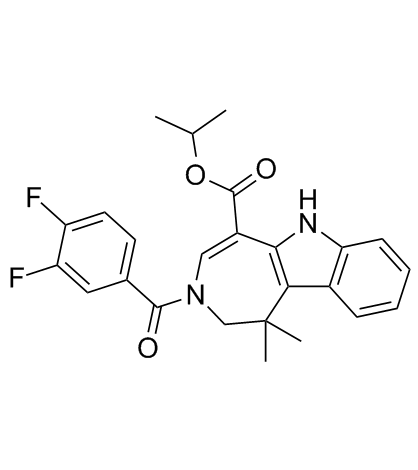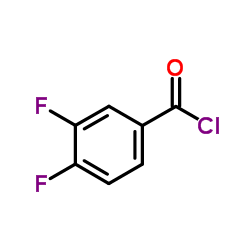629664-81-9
| Name | propan-2-yl 3-(3,4-difluorobenzoyl)-1,1-dimethyl-2,6-dihydroazepino[4,5-b]indole-5-carboxylate |
|---|---|
| Synonyms |
UNII-S6KDM312I5
3-(3,4-difluorobenzoyl)-1,1-dimethyl-1,2,3,6-tetrahydroazepino[4,5-b]indole-5-carboxylic acid isopropyl ester FXR-450 Turofexorate isopropyl [USAN] Azepino[4,5-b]indole-5-carboxylic acid, 3-(3,4-difluorobenzoyl)-1,2,3,6-tetrahydro-1,1-dimethyl-, 1-methylethyl ester Isopropyl 3-(3,4-difluorobenzoyl)-1,1-dimethyl-1,2,3,6-tetrahydroazepino[4,5-b]indole-5-carboxylate turofexorate isopropyl WAY362450 XL335 WAY-362450 |
| Description | WAY-362450 is a potent, selective, and orally bioavailable FXR agonist with EC50 of 4 nM. |
|---|---|
| Related Catalog | |
| Target |
EC50: 4 nM (FXR)[1] |
| In Vitro | WAY-362450 is a potent, selective, and orally bioavailable FXR agonist (EC50=4 nM). WAY-362450 is highly selective, as no significant cross-reactivity with these receptors (LXRα, LXRβ, PPARα, PPARγ, PPARδ, RXRα, RARγ, VDR, SXR, ERα, ERβ, GR, AR, MR, and PR) is observed at concentrations up to 10 μM. WAY-362450 displays potent agonist activity in the FXR reporter gene assays and on FXR target genes in cell-based assays. In promoter assays, utilizing reporter constructs under control of the human bile salt excretory pump (BSEP), human small heterodimer partner (SHP), and mouse intestinal bile acid binding protein (IBABP) genes are up-regulated by WAY-362450 with EC50 of 17, 230, and 33 nM, respectively. In addition, WAY-362450 significantly induces mRNAs encoding for BSEP, SHP, and IBABP in human cell cultures at 1 μM (13-, 2-, and 20-fold, respectively)[1]. WAY-362450 potently induces luciferase reporter expression with an EC50 of 16 nM. WAY-362450 is a potent stimulator of endogenous FXR gene activation in mouse AML12 cells and in primary human hepatocytes[2]. |
| In Vivo | WAY-362450 also shows potent effects on cholesterol and triglyceride lowering in LDLR-/- mice and antiatherogenic activity with respect to reduction of aortic arch lesions. Oral administration of WAY-362450 to LDLR-/- mice results in lowering of cholesterol and triglycerides. Chronic administration in an atherosclerosis model results in significant reduction in aortic arch lesions. WAY-362450 is dosed in rat at 3 mg/kg (po and iv) and shows good oral bioavailability (38%). There is a protracted half-life of 25 h, modest volume of distribution, and low clearance (3.3 L/kg, ~10% of hepatic blood flow). Additional pharmacokinetic studies in mice and higher species have been completed, and the data will be reported elsewhere[1]. In rats, WAY-362450 results in an elevation in HDLc levels, whereas in hamsters it causes a reduction similar to that observed in mice[2] Treatment of wild-type mice with 30 mg/kg WAY-362450 results in induction of SHP expression in wild-type mice but not in FXR-/- mice. Consistent with the known effects of SHP induction on bile acid synthetic gene expression, WAY-362450 strongly represses expression of the CYP8B1 bile acid synthetic gene in wild-type mice but had no effect on CYP8B1 gene expression in FXR-/- mice[3]. |
| Cell Assay | Mouse AML12 cells are plated at 200,000 cells/well on the 24-well plate in 1 mL of growth medium [DMEM/F12 10% FBS, 1% penicillin and streptomycin, 1% insulin-transferrin-selenium-G supplement (ITS), 0.1% Dexamethasone (40 ng/mL)/well. The cells are treated with increasing concentrations of WAY-362450 (0.001, 0.01, 0.1, 1 and 10 μM) or GW4064 for 24 h. Total RNA is prepared and analyzed by real-time RT-PCR, and short heterodimer partner (SHP) expression is normalized to GAPDH and reported as fold induction vs. vehicle-treated cells. Preplated 24-well plates of human male primary hepatocytes with matrigel overlay are obtained from Cellz Direct. Cells are maintained in serum-free Williams medium E and supplemented with penicillin/streptomycin, dexamethasone, ITS, L-glutamine, and HEPES buffer. They are treated overnight with vehicle (0.01% DMSO) or increasing concentrations of WAY-362450 or GW4064. Total RNA is purified using the Qiagen RNeasy clean kit, and gene expression is quantified by real-time RT-PCR with the Qiagen Quantitech kit using an ABI 7900. The relative amount of mRNA is normalized to 18S ribosomal RNA, and data shown represent an average of two independent experiments[2]. |
| Animal Admin | Mice[3] Age- and sex-matched 8- to 12-week-old mice are fed standard chow and housed in temperature-controlled virus-free facility on a 12-h-light/dark cycle with free access to food and water. Where indicated, mice are fed either a Western diet containing 42% fat and 0.2% cholesterol by weight or this Western diet supplemented to contain 0.225 mg WAY-362450 per gram of diet. The mice consumed ~4 g diet per day, resulting in the delivery of ~30 mg of WAY-362450 per kg of body weight, assuming a 30 g body weight. Animals are maintained on these diets for 6 (apoE-/-) or 12 weeks (LDLR-/-). At the end of each study, animals are euthanized and blood samples collected via the orbital eye for lipid analysis. Liver and ileum tissue are removed for mRNA quantification, and aortas are removed and stored in 10% buffered formalin solution. Rats[2] Eight-week-old male Sprague Dawley rats and Syrian Golden hamsters are fed a 60% fructose/0.15% cholesterol diet. For the rat study, the rats are placed onto the diet for 2 wk and then treated by daily oral gavage with vehicle (80% polyethylene glycol/20% Tween) or varying concentrations of WAY-362450 (8/group) as indicated for 7 days (8 rats/group). The hamster study is conducted as a preventative treatment, so both the diet and drug treatments are initiated on day 1 and continued for 21 days (8 hamsters/group). On the last day after the final dose, the food is removed to allow a 3 h fast, and serum and liver are harvested for analysis as described above. |
| References |
| Density | 1.3±0.1 g/cm3 |
|---|---|
| Boiling Point | 617.3±55.0 °C at 760 mmHg |
| Molecular Formula | C25H24F2N2O3 |
| Molecular Weight | 438.466 |
| Flash Point | 327.1±31.5 °C |
| Exact Mass | 438.175507 |
| PSA | 62.40000 |
| LogP | 5.59 |
| Vapour Pressure | 0.0±1.8 mmHg at 25°C |
| Index of Refraction | 1.600 |
| Storage condition | -20℃ |
| Symbol |

GHS07 |
|---|---|
| Signal Word | Warning |
| Hazard Statements | H315-H319-H335 |
| Precautionary Statements | P305 + P351 + P338 |
| RIDADR | NONH for all modes of transport |
|
~% 
629664-81-9 |
| Literature: Journal of Medicinal Chemistry, , vol. 52, # 4 p. 904 - 907 |
| Precursor 2 | |
|---|---|
| DownStream 0 | |

